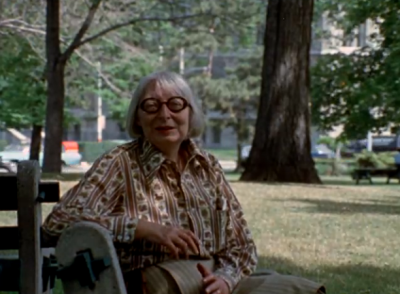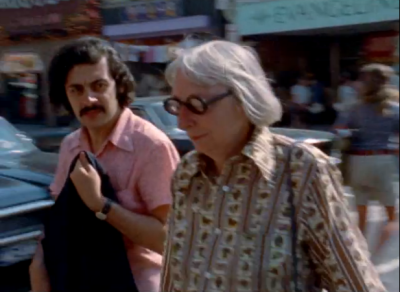
Like a boss.
We went to see the new Jane Jacobs documentary Citizen Jane: Battle for the City. It’s pretty good, with plenty both for Jacobs fans and those who don’t know her work. It pulls in some big-name contributors, including Saskia Sassen, Michael Sorkin, Mindy Fullilove, Mike Davis (!) and Geoffrey West (*). But it also – perhaps unintentionally – shows up some of the limits of Jacobs’ thinking as it applies to today’s cities. Here’s a review of sorts.
*
The film has two particular strong points. The first is the precis of Jacobs’ most famous work, The Death and Life of Great American Cities. Director Matt Tyrnauer nicely summarise the key ideas: cities as organised complexity; street life as a ‘dance’ of uses and users; the rebellion against modernist city planning, cities for the car, and high rise living; the importance of ‘eyes on the street’, mixed uses, old and new buildings, and short blocks – concepts now hard coded into masterplans and design standards in cities across the world. Crucially, these ideas developed over many years’ close observation of New York streets and neighbourhoods, and through test runs in Jacobs’ journalism: her first book arrived in the world fully formed and ready for use.

The film’s other big plus is its retelling of the epic struggle between Jacobs and city planner Robert Moses in 1950s and 60s New York. With minimal resources, Jacobs somehow turned around Moses’ big money plans to bulldoze and run roads through Washington Square Park, the West Village and ultimately Lower Manhattan itself. These are perhaps the most gripping parts of the picture. Moses is a monstrous figure – see also Robert Caro’s 900-page biography, summarised here by Jackson Lears – while Jacobs is revealed to be a total badass.
Machine politics, corruption and the abuse of power run up against agile and well-networked social activism: we see Jacobs wearing a ‘Mailer for Mayor’ badge, organising a series of brilliant publicity stunts and photo opportunities, and roping in Susan Sontag, Margaret Mead and Eleanor Roosevelt to help out.

The gender dynamics are striking. Moses summons an army of besuited male planners, and notoriously dismisses Jacobs’ female-led network as ‘just a bunch of mothers’: fatally underestimating his opponents, but also, as a talking head points out, ’you’d only say that if you thought people didn’t matter at all’. Jacobs’ publisher sends Moses a copy of Death and Life: he returns it in a terse note (‘Sell this junk to someone else’); Lewis Mumford dismisses the book as ‘Mother Jacobs’ Home Recipes’.
The filmmakers link Jacobs’ tactics and successes to other 1960s social struggles: feminism, the environmental movement, civil rights. There’s an important point here about shared repertoires of protest tactics. It’s also true that Jacobs was both a feminist and an environmentalist. But I needed a bit more convincing that the bigger links really held together.
*
The racism in US post-war urban planning is still shocking to see. James Baldwin appears in the film to point out that ‘urban renewal means negro removal’, with housing projects and highways used as tools of segregation. The minority urban poor were pushed into badly designed blocks at the city’s edge, just as in France the following decade – with similarly grim results for the victims.
The film starts to connect these practices to Moses’ development model, which raised land values in redeveloped zones, and leveraged huge federal budgets. I was left wanting to know more about the political economy: was this racial redlining? Patronage politics? Or some toxic mixture of the two?
The Cross-Bronx Expressway (1948-72) is perhaps one of the most notorious Moses schemes, literally cutting the neighbourhood in half and blighting lifechances for years afterwards. As Mike Davis points out, it’s ‘perhaps the single most damaging urban development in US history’. Jacobs was active in New York at the time, and the film is curiously silent about this. Was she involved in opposing this? If not, why not? Did she try and fail? (Was her model of protest anchored in the neighbourhoods she knew? Did construction help spur her into action elsewhere in the city?)
*
If the film is sometimes in danger of reifying Jacobs’ older ideas, it also misses out some of her newer thinking. That’s a shame: The Economy of Cities (1969) is a foundational text in urban economics, with important ideas about how cities help innovation to happen, long term growth and urban resilience. Cities and the Wealth of Nations (1985), which posits cities over nation-states as the key unit of development, feels ahead of its time. And her environmental work – which I know less well – also looks increasingly prescient.
The film also skips some chances to reassess that legacy. Jacobs was a progressive and a futurist – but not a fan of big government. Her anti-planning stance has made her popular with the libertarian right: it’s the antithesis not just of the government cynicism that produced Pruitt-Igoe and Ronan Point, but also the state-funded optimism that gave us the LCC and Park Hill.
Sure, the Lower Manhattan Expressway would have been a concrete stake through the city’s heart. But I dare you not to look at the renderings and at least wonder what a Brutalist icon it would have made.

Some of the limitations in Jacobs’ vision become clearer in the second half of the film, which lays up Jacobs’ neighbourhood prescriptions against urbanisation outside the West. As Saskia Sassen puts it, the pace and style of urbanisation in the urban cores of China and India are ‘Moses on steroids’ . ‘How can we apply Jane Jacobs’ thinking to these cities?’, asks another contributor.
Good question. The film drops some hints: successful urbanisation can’t shut out the public realm; cheaply-built towers are a terrible false economy; existing urban settlements, however visually shabby or informal, embody their own ‘dances’ and should be valued by planners, not bulldozed away (see Stewart Brand for more on this).
Nevertheless, the film can’t escape the conclusion that Death and Life … has plenty of say about preserving old neighbourhoods in old cities, but rather less about building new ones: Jacobs’ New York was losing population, as their heavy industry began to be globalised away; the cities of the BRICS are growing at speed. Equally, today’s New York is struggling with an affordable housing crisis; other US cities are still feeling the aftershocks of de-industrialisation.
As Jacobs put it in 1958: ‘the best way to plan a downtown is to see how people use it today; to look for its strengths and to exploit and reinforce them.’ Today’s urban crises need urgent solutions, and significantly, by her death in 2006, Jacobs didn’t seem so interested in these issues: as her last interviews show, she had moved on to other things.
*
The film is a great appreciation of Jane Jacobs’ finest hour. Her elegant and radical thinking was inevitably a product of its time. But bettering our contemporary cities may require both a re-tooling of Jacobs’ ideas, and new thinking from other voices.
















 As some of you will know,
As some of you will know, 



 We finally watched
We finally watched  What’s on sale here?
What’s on sale here?